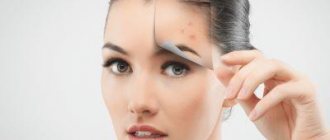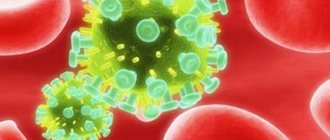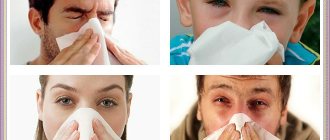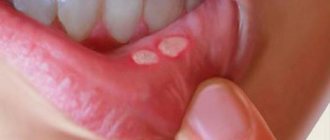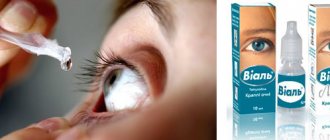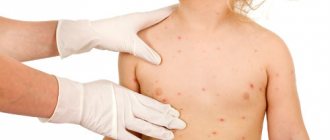A small rash on the eyelids and under the eyes occurs in adults and children, regardless of gender. The skin in the area of the visual organs is delicate, so it quickly succumbs to irritation. Most often, the cause of this process is an allergic reaction, but more serious pathological processes can also be provoking factors. If small pimples appear on your face and create aesthetic discomfort, you should consult a dermatologist. Therapy depends on the etiology of the process and the type of rash.
Possible reasons
All rashes near the eyes can serve as external signs of serious illnesses, so you should not ignore them. A rash indicates a disorder in the body. The main reason is allergies. In this case, the rash disappears after the allergen is isolated. A red rash usually appears, with additional swelling, tearing, runny nose, and redness. Allergic acne appears as a result of exposure to cosmetics, household chemicals, and dust. Food, exposure to the sun or cold can also cause allergies. The following pathological factors can provoke a rash:
- dermatitis;
- herpes virus;
- amyloidosis;
- demodicosis;
- fungal infection;
- stress;
- hormonal imbalance;
- hypovitaminosis;
- malignant oncological processes.

Acne can be caused by infectious and skin diseases, then symptoms will be observed throughout the body. The main provoking factor is non-compliance with personal hygiene rules for skin care. The thin structure of the skin in the corners of the eyes and under them leads to irritation. A small rash under the eyes of a child is a common but temporary phenomenon. A baby's skin is delicate and easily irritated.
Common Causes of Rash Around the Eyes
Symptoms of atopic dermatitis include the following:
- dry flaky spots that gradually appear on the affected areas of the skin;
- persistent itching;
- the formation of a crust on the skin, which ultimately leads to bleeding and redness, inflammatory processes on the human skin.
An allergic reaction may be associated with increased sensitivity of the body's defense system to any substances. When an allergic reaction occurs, the area around the eyes becomes dry, rash, and inflamed. There are a number of causes of an allergic reaction that causes a rash to form around the eyes. Among them the main ones are:
- food allergies from certain groups of substances entering the body (for example, peanuts, fish, milk, eggs and wheat);
- any skin contact with plant pollen.
The symptoms in this case are:
- lacrimation;
- rash around the eyes;
- itching feeling.
Contact dermatitis occurs when the skin is exposed to allergies caused by irritants. Any contact with allergens or irritants causes the skin to react, causing redness, irritation and inflammation. This is one of the most common and predominant causes of rashes around the eyes. People who have previously had atopic dermatitis are most likely to be at risk of developing this disease.
It has been established that quite often the causes of contact dermatitis are:
- skin contact with nickel;
- skin contact with certain types of soap;
- use of deodorants and detergents.
Symptoms of the disease include:
- peculiar red spots;
- noticeable thinning of the skin;
- dryness and the formation of crusts and blisters on the damaged area.
It should be noted that one of the most dangerous causes of rashes around the eyes is Lyme disease, which is transmitted to humans by the bite of an insect called a spirochete, or Borrelia burgdorferi. The bite breaks through the body's special protective barrier, which allows the insect to transmit pathogenic infections to the body. We are primarily talking about a tick-borne disease, which is present in abundance in the northern hemisphere. Symptoms of the disease are:
- unpleasant itching;
- rash;
- fever;
- severe and prolonged headaches;
- fatigue;
- deterioration of the nervous system uncharacteristic for humans.
Hay fever is one of the many possible causes of eye rashes. It occurs due to the development of air allergies. In this case, the following symptoms appear:
- watery eyes;
- dangerous chest congestion;
- the appearance of red spots on the skin.
Histamines are widely known in the treatment of this type of skin allergy.
It has been found that rubber swimming goggles can cause rashes around the eyes. People who swim professionally and amateurly often wear glasses too tightly, which is a prerequisite for the development of a skin reaction to the rubber of the glasses.
One of the current causes of rashes under the eyes is the lack of time for proper sleep. To get enough sleep, a person needs a certain number of hours, which allows him to promptly avoid the appearance of red spots around the eyes.
Everyone understands that a rash around a child’s eyes can appear from dirt. This applies to adults to a lesser extent, because few people do not care about their hygiene at all, therefore, if you have rashes under your eyes, then, most likely, you have them for a completely different reason. It is worth considering each of them in more detail:
- Allergy. Papules occur due to the ingestion of various products or agents, as well as under the influence of external influences, for example due to the use of low-quality cosmetics, etc. The rash may appear due to wind, cold temperatures or sun exposure.
- In case of metabolic disorders. This happens due to an unbalanced diet or due to a systemic disease.
- Hormonal imbalances. They do not always occur only in teenagers. Adults are also susceptible to this condition; as a result, excess sebum production leads to the appearance of pimples under the eyes and in other places on the skin. Very often this happens before menstruation or while taking hormonal contraceptives.
- Lack or excess of vitamins. At this time, the first signal will be a rash in various places on the body and face. With vitamin deficiency, skin rashes most often occur in winter and early spring.
- The presence of internal inflammatory processes, infections or helminthic infestations.
- Fungus or dermatological diseases.
- The presence of stress in a woman’s life. This may include nervous breakdowns, prolonged experiences, depression, psychosis, etc. In these cases, skin spots may appear not only under the eyes, but also on the neck, chest and other parts of the body.
Thus, when starting procedures for cleansing the skin of a rash, first of all find out the reason for its appearance. Treatment should be comprehensive; by eliminating only the external defect itself, you will not get rid of the problem; over time, the rash will reappear.
The presence of comedones in an adult is not uncommon. Despite the fact that these types of acne are mostly found in teenage children, in adults the sebaceous passages sometimes become clogged, which causes acne.
Comedones are divided into 2 types:
- White - closed type.
- Black - open type.
Closed comedones are more dangerous, since inflammation may begin in the tissues adjacent to them. In adulthood, women may experience milia. These are small whitish pimples, similar to millet grains, that accumulate in the area under the eyes. Doctors say that such milia indicate problems with the liver.
The clinical picture of different diseases may be similar, but there are usually specific symptoms that help make a diagnosis.
Rashes on the eyelids
A rash in the eyelid area is most typical of dermatitis, eczema and demodicosis.
A dermatologist can recognize the cause of the disease, and you should contact him if a rash appears.

Eczema has many clinical forms, but dry eczema most often occurs on the eyelids. It is characterized by redness of the skin and subsequent peeling. It responds well to treatment, but after some time there is a high probability of relapse.
Dermatitis develops with a hereditary predisposition to atopy. And trigger factors can cause a reaction on the skin. It usually manifests as redness of the eyelids and itching in the area.
Demodicosis is caused by the demodex mite. It has the following manifestations:
- Redness of the edges of the eyelids occurs.
- Small scales appear in the area of the roots of the eyelashes.
- Swelling of the skin around the eye is characteristic.
- Itching is a typical symptom of this disease.
- An incompletely treated process can lead to the formation of stye.
- Subsequently, eyelash loss may occur.
Allergy
Allergy is a concept that combines several diseases.
The most common manifestation on the skin is allergic contact dermatitis. It develops when certain allergens come into contact with the skin of the eyelid. Women often experience rashes on their eyelids due to allergies to cosmetic components.
Many people are interested in what it is called when there is a rash around the eyes and swelling of the skin. This condition is called Quincke's edema. Another manifestation of allergies, which has the following features:
- It develops quickly when the allergen re-enters the body.
- The reaction is violent and pronounced: the skin quickly turns red, the eyelids swell.
- The general condition of a person also worsens.
- Possible swelling of the tissue in the neck and laryngospasm, which impair breathing.
- Requires emergency assistance.
In case of Quincke's edema, the patient should be given antihistamines, call an ambulance, and ensure that fresh air enters the room. Chronic allergy sufferers have syringes with adrenaline or corticosteroids in stock in case of such reactions.
Rashes in the form of red dots can occur under different conditions:
- Dermatitis or eczema described above. They may have manifestations such as small red dots that do not protrude above the surface of the skin.
- Viral skin lesions during herpetic infections. Usually characterized by the appearance of small bubbles with transparent contents.
- Acne in the eyelid area. Red and black dots that can become blisters with purulent contents.
Under the eyeball
In systemic connective tissue diseases, it is not the skin of the eyelids itself that is most often affected, but the dermis around and under the eye:
- A butterfly rash on the cheekbones is characteristic of lupus. It is an autoimmune disease that may have only skin symptoms or be systemic in nature.
- Heliotrope rash with dermatomyositis - red or brown spots around the eyes. This is one of the symptoms of skin damage during a serious illness. Dermatomyositis also causes muscle weakness, but this may appear later.
Due to the tenderness of the skin of the lower eyelids and the area around them, as well as the looseness of its subcutaneous fatty tissue, circulatory disorders in this area are more a system than a rarity, and in addition to edema, they are often manifested by the presence of a variety of rashes (both systemic and random).
An important factor in the appearance of a rash here is the abundance of glands - both the skin’s own (sweat and sebaceous) and those that serve to maintain the eyelashes.
In addition, the connection between the area and the nasal cavity through the nasolacrimal duct is important, as a result of which the mucous membranes of the nasal cavity and the conjunctiva can safely be considered a single field of activity for various factors unfavorable to the life of the skin.
The category of rash does not include such structural features of the skin as a capillary network with individual elements especially close to the surface visible through its thin thickness, or a scattering of small moles around the eyes of a child, or the presence of telangiectasia, hemangiomas.
We are talking about the appearance of temporary or periodic skin changes due to the following reasons:
- allergic;
- infectious;
- combinations of the first two;
- others.
Types of rash
A rash in the area of the visual organs appears at any age. Certain types of rashes are observed on the skin all the time. These include white, hard growths that do not cause serious danger. Most acne occurs under the influence of external factors and then disappears. All possible rashes are divided into several types:
- small rash;
- blisters with watery filling;
- nodules in the form of papules;
- red pimples with scales.
Causes and methods of treating allergies on the eyelids of the eyes in children and adults

Allergy to the eyelids is not only a reaction to low-quality cosmetics. Any other allergens, including house dust or flowering plants, can lead to this situation. So first you need to eliminate any contact with irritants and not use cosmetics for a while. Other treatment depends on how exactly the allergic reaction manifests itself.
The causes of allergies are always associated with the body's reaction to certain irritants. But it also happens that it is combined with other diseases - bacterial and viral infections, which gives a complex clinical picture.
- 1. Types
- 2. Conjunctivitis
- 3. Blepharitis 3.1. Accession of the disease
Allergies around the eyes manifest themselves in different ways. The following types are distinguished:
- 1. Conjunctivitis. With it, the eyelids become very red, irritation appears, but most importantly, the conjunctiva is affected.
- 2. Keratoconjunctivitis. This form usually appears in the spring. Most often it occurs in children under 12 years of age. But adults also suffer from it. Keratoconjunctivitis has a long and sluggish course.
- 3. Drug allergies. It manifests itself with many symptoms, including redness of the skin of the eyelids. This reaction develops within an hour after taking any medication.
- 4. Blepharitis caused by a reaction to food allergens, household chemicals, respiratory irritants, as well as accompanying atopic dermatitis.
- 5. Pollinous blepharitis. This form is characterized by seasonal exacerbations, usually during spring and summer, as it is caused by flowering plants.
- 6. An allergic reaction caused by parasites. Most often these are demodexes - microscopic mites that always live on human skin, but under favorable conditions they begin to multiply rapidly. In this case, treatment consists of the use of special acaricidal drugs. But only a doctor can prescribe them based on the results of the examination.
How does it manifest?
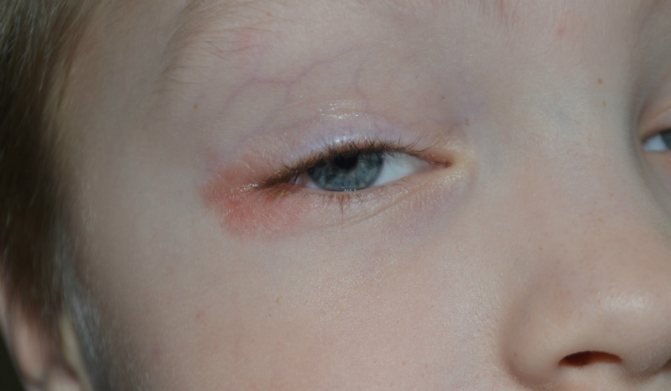
The symptoms of the process depend on the etiology of the rash. In most cases, acne is not a serious concern. If the formation itches, we are talking about a pathological process and additional diagnostics are required. The most alarming symptom is the formation of scales. They cause severe itching and affect a person’s emotional state. Associated symptoms may include the following:
- Itching and dryness are observed with dermatitis and allergies.
- Redness and hyperemia occurs against the background of hormonal imbalance.
- A dense, itchy papule is a sign of amyloidosis.
- The formation of yellow plaques warns of a malignant process.
Painless growths in the corners or under the eyes are comedones. This is the most common type of rash and is not dangerous. Comedones occur as a result of blockage of the sebaceous glands and act as a type of acne. White round pimples represent the open type, while blackheads represent the closed type. They are not life-threatening, but create cosmetic discomfort.
Possible complications
Allergic reactions on the eyelids, left unattended or in the absence of adequate therapy, can cause more dangerous pathological conditions affecting not only the eyelids, but also the eyes themselves:
- Eczema of the eyelids - skin lesions on the eyelids, when the initial symptoms in the form of itching and peeling are replaced by deeper changes, as a result of which the skin becomes constantly inflamed, with redness and the presence of small blisters, papules and pustules;
- Glaucoma is a consequence of increased IOP during angioedema, one of the manifestations of allergies. In the long term, glaucoma leads to a decrease in visual acuity and its complete loss;
- Chronic allergic conjunctivitis - constant irritation on the eyelids causes chronic inflammation of the mucous membrane of the eyeball, since a common cause of allergies on the eyelids is the Demodex mite and its toxins.
Allergies on the eyelids can become a provoking factor for inflammatory processes in various eye structures: conjunctivitis, keratitis, corneal ulcers. Even infectious processes easily begin in the affected areas, since the immune system is already activated here, and new forces are needed to suppress the infection.
Diagnostics
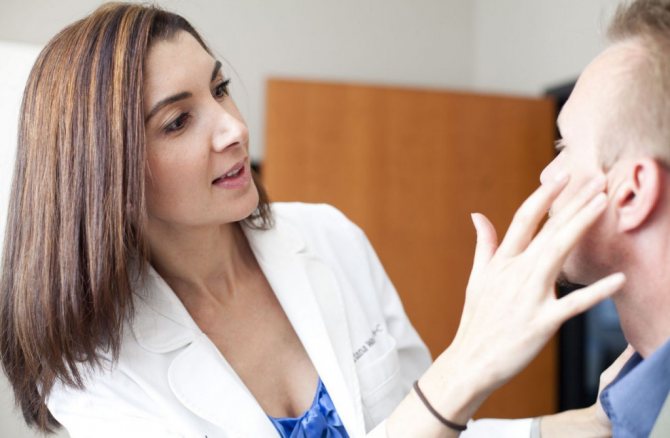
If a rash appears in the eye area, do not immediately consult a doctor. In most cases, it disappears on its own after 1-2 days. The danger arises if the pimples spread and cause painful symptoms. Diagnosis is carried out by a dermatologist; if necessary, consultation with an oncologist, endocrinologist or surgeon is necessary. During the diagnostic process, the doctor determines the etiology and type of formation. To determine the diagnosis, you need to study a complete history. If an infectious nature of the rash is suspected, a number of laboratory tests are prescribed.
Allergy on eyelids treatment and diagnosis
Experienced allergy sufferers and completely healthy people may encounter manifestations of allergies on their eyelids at any time; it is important to consult with an ophthalmologist to rule out inflammatory eye diseases and demodicosis and begin the right treatment.
The specialist will examine the eye and eyelids, if necessary, take an analysis of the discharge, eyelashes for microscopic analysis, check the fields and visual acuity, and examine the fundus of the eye. Serum tests are also done to diagnose the immune status and assess the intensity of the allergic response.
If an allergy is identified on the eyelids, treatment begins immediately:
- Eliminating the allergen;
- Local therapy (antihistamines, antimicrobials, hormonal ointments and drops);
- Taking antiallergic drugs;
- Therapeutic laser treatment;
- Healing and moisturizing ointments and drops;
- Specific desensitizing therapy.
The latter method is used when it is not possible to get rid of contact with the allergen. It consists of intradermal injection of an allergen in increasing dilutions; the immune system, as it were, learns to be in contact with the allergen and not respond to it. The method is carried out without exacerbation and for certain indications, if allergies on the eyelids, treatment in this way allows you to forget about the problem for two to three years.
Treatment of the disease
Therapy depends on the cause of the rash, so you should not treat it yourself without an accurate diagnosis. In most cases, symptoms disappear on their own. If there is no improvement, drug therapy is prescribed. The doctor chooses the regimen individually, depending on the etiology of the process and the age of the patient. As additional means, non-traditional methods using plant extracts are used.
Surgery is used extremely rarely. A laser is used to remove a papule or plaque if it does not respond to conservative treatment.
Medications

Treatment with medications is carried out after diagnosis, when the exact diagnosis is known. If the rash does not disappear within 2-3 days, medications are prescribed depending on the situation. During the treatment process, it is very important to adhere to the rules of care. You should also stop taking other medications if possible. The dermatologist prescribes the following groups of topical drugs:
- antihistamine ointments on a hormonal basis ("Cinacort", "Prednisolone") and non-hormonal ("Radevit", "Hydrocortisone");
- antibacterial drops “Tobex”, “Levomycetin”;
- anti-inflammatory ointments "Nystatin".
During therapy, corrective laboratory tests are performed. In case of hormonal disorders, the emphasis is on eliminating the primary cause, and a special therapeutic regimen is prescribed. Additionally, vitamin complexes are introduced. To eliminate rashes on the face, vitamin E is used, which contains an antioxidant that improves metabolic processes in the skin.
Folk recipes
Alternative medicine is allowed in the treatment of skin rashes on the face, but only with the permission of a doctor. If the diagnosis has not been established, you should not use folk remedies, this may worsen the situation. Cold compresses and facial baths are considered harmless. To prepare them you need strong black tea. The following recipes are used for therapeutic purposes:
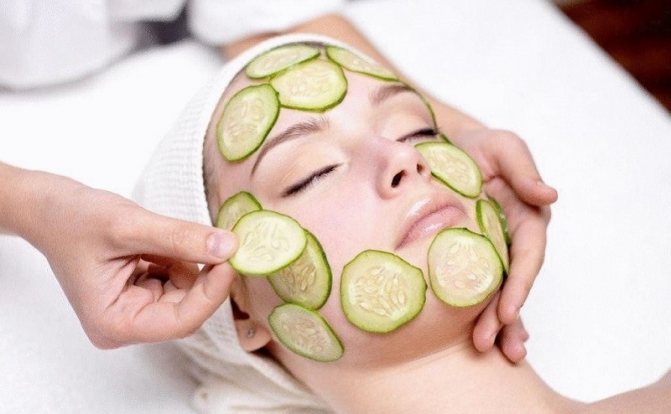
A cucumber mask copes well with the problem.
- cucumber mask to relieve inflammation;
- decoction of oak bark to cleanse pores;
- wheat oil with celandine as a scrub;
- nourishing lemon mask;
- melt water and bay leaf from peeling.
Folk remedies
Traditional medicine can be used only after identifying a causally significant stimulus for urticaria after consultation with your doctor. With idiopathic urticaria, the body's reaction to herbal components is not predictable, so the expected benefits do not justify the possible complications.
Cleansing the body
Before going to bed, flaxseeds (1 tbsp) are poured with cold boiled water and left to infuse until the morning. After waking up, the infusion is mixed and drunk 30 minutes before breakfast.
- cabbage leaves 100 g;
- green apple 1 pc.;
- banana 1 pc.;
- parsley 100 g;
- water 100 ml.
The crushed components are mixed in a blender until smooth. Cleansing smoothie is taken 1-2 times a day 1 hour before meals.
Elimination of neuroses
To control the emotional background, decoctions and infusions of sedative plants are used.
For daily use, it is enough to brew 1 tsp. any herb in 200 ml of boiling water and leave for 5-7 minutes. Regular use 1-2 times a day is most effective.
Prevention
For patients with problem skin, it is worth following some rules to avoid rashes on the face and around the eyes. First of all, you should avoid foods that cause allergies. All cosmetic products must be selected individually. The skin should be protected from direct sunlight, strong wind and frost. If pathological symptoms occur, you should consult a doctor.
The issue of preventing rashes in women during the period of hormonal changes is especially acute. During pregnancy, such symptoms are often observed, so it is recommended to use moisturizing creams and masks. It is better to select products with a cosmetologist. To keep your skin clean and free from acne, you need to protect yourself from stress and nervous shock.
Hives: what is it?
According to statistics based on dermatological practice, urticaria occurs at least once in a lifetime in 20% of the population. In 30% of all cases, the disease becomes chronic, often caused by the lack of timely treatment.
Development mechanisms
The basis of the pathogenesis of urticaria is the release (degranulation) of histamine from mast cells of the skin, where it is synthesized and accumulated.
It is a mediator of allergic reactions and a participant in inflammatory processes. On the face, mast cells are located in the connective tissue of the skin. On their surface there are receptors for immune system antibodies produced when the body comes into contact with a foreign compound (allergen).
After antibodies bind to receptors, the structure of the mast cell membrane changes, and the histamine contained in them is forced out of the granules through the pores.
And a little about secrets...
Have you ever had problems with Itching and irritation?
? Judging by the fact that you are reading this article, you have a lot of experience. And of course you know firsthand what it is:
- scratch irritation
- wake up in the morning with another itchy plaque in a new place
- constant unbearable itching
- severe dietary restrictions, diets
- inflamed, bumpy skin, spots….
Now answer the question: Are you satisfied with this? Is it possible to endure? How much money have you already wasted on ineffective treatment? That's right - it's time to end them! Do you agree? That is why we decided to publish an interview with Elena Malysheva, in which she reveals in detail the secret of why the skin itches
and how to deal with it. Read the article...
Each of us tries to take care of our appearance and wants to look as good as possible. Therefore, a pimple under the eye can ruin not only your image, but also your mood. Such a nuisance can arise for a variety of reasons, not always harmless. If a pimple under a man’s eye does not cause much embarrassment, then for the fair sex it is a real disaster, because it is quite difficult to disguise it. Why does this problem still arise and how to deal with it? How to remove a pimple under the eye yourself?
This question is especially relevant today. A pimple under the eye - the photo is ruined, the appearance is not flawless, plans are derailed. This is exactly how representatives of the impressionable fair sex react. For some superstitious people, a pimple under the eye is necessarily a sign, an omen of something (but a pimple under the left eye is an unkind omen, but more on that later).
If there are white pimples under the eyes
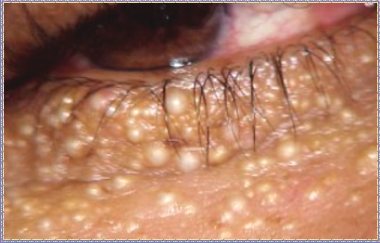
Any, even small, pimple under the eye causes not the most pleasant feelings for girls. Nevertheless, everyone has encountered such a problem as white pimples under the eyes. Small, whitish-yellowish in color, somewhat similar to wen. People call them millets, and doctors call them milia. They appear several at a time, and it’s hard not to notice them.
Such skin formations do not pose any danger. Harmless white pimples under the eyes sometimes appear even in newborns. In their structure they are similar to miniature cysts. Inside small granular bubbles formed due to clogging of pores or sebaceous ducts, a large amount of keratin accumulates. This is the name given to dead skin cells that are no longer capable of dividing.
A similar pimple under the eye can be caused by the following reasons:
- hormonal imbalance. For this reason, millet grains are often observed in women during menopause and during menstrual cycle irregularities, in teenage children, and during pregnancy;
- long-term exposure to ultraviolet radiation. This radiation makes the skin rougher and interferes with the natural exfoliation of dead cells, which leads to this problem;
- dysfunction of the thyroid gland. If millet lesions appear frequently and you can’t get rid of them, then you should visit an endocrinologist’s office;
- external pollutants and cosmetics that clog skin pores. In this case, simply change your eye care products. By the way, sheets can also appear from excessively frequent use of scrubs and peeling;
- poor nutrition and insufficient water consumption (namely water, not tea, coffee or juices);
- restoration of skin after severe injuries, burns and abrasions.
There can be many reasons; we are always more interested in the solution. Once a pimple appears under the eye, what should you do?
How to remove white pimples under the eyes?
On the Internet you can find many questions like “I squeezed out a pimple under my eye, it’s swollen. What to do?" First, let's figure it out: pimples under the eyes, no matter what causes them, should under no circumstances be squeezed out. First, damage the skin and prevent the body from coping with the problem on its own. Secondly, the secretion of these unwanted formations, when they come into contact with the mucous membrane of the eye, can cause complex complications and various infections.
So how to get rid of white pimples under the eyes? If funds allow, then do not skimp and go to the salon. Using special equipment, experienced cosmetologists will perform deep skin cleansing. For these purposes, vacuum cleansing methods, special vaccines, and absorbable skin compactions are used today. As a result, you will not easily get rid of hated pimples, you will get clean and smooth facial skin.
And at home, you can carry out a number of procedures that can remove even a large pimple under the eye from your face. Of course, they take time, but they are a great way to save money.
The first way is semi-surgical. You will need a sterile insulin syringe. Cleanse your face thoroughly. Steam it to open the pores. A steam bath can be arranged simply over hot steam, or over a herbal decoction (chamomile, calendula, Ivan tea and others). After this, you need to disinfect the skin with alcohol or lotion based on it. Using a syringe, lightly pierce the vial and smoothly squeeze out its contents with two fingers. After getting rid of the white clot, wipe the skin with alcohol again. After the procedure there should be no pain left, otherwise consult a dermatologist. Remember that your hands and syringe also need to be thoroughly cleaned.
Herbal steam baths are very beneficial. But you should not use them in cases where the pimple under the eye is swollen. In these situations, it is worth resorting to the help of pharmacists. Anti-inflammatory ointments such as skinoren, erythromycin, zinerit and others.
Recipes for masks for acne under the eyes
If a pimple has popped up under your eye and is swollen, you need to act immediately. If there is no opportunity to visit professionals, then folk remedies will help you. Homemade masks will help cope with acne under the eyes, and also make the skin matte and smooth. Of course, with proper and regular use. What will help us if a pimple appears under the eye?
The simplest and most effective composition: viburnum juice and oatmeal. You can add chopped oatmeal flakes. Mix half a glass of dry ingredients with fresh viburnum juice to the consistency of rich sour cream. Apply to problem areas and keep the mask on for at least forty minutes. Afterwards, rinse everything off with warm water.
A milk mask is also effective when a pimple has popped up, the under eye is swollen and red. Mix boiling milk, water and grated cucumber pulp without seeds and peel in equal proportions. Let the mixture sit for an hour in a warm, dark place. Prepare the base of the mask from light natural fabric, preferably not dyed. Be sure to provide slits in the canvas for the eyes, nose and mouth. Keep the cloth soaked in the mixture on your face for at least 30–40 minutes. Afterwards, wash your face with cool water without using any cosmetics.
A yeast spot mask is good for mild rashes in the area around the eyes. Mix 50 grams of dry baker's yeast, 30 grams of warm flower honey and 15 grams of hydrogen peroxide. The mixture should be applied directly to the milium and kept for no longer than 15 minutes. Then rinse off. This mixture will not only help get rid of acne, but also cope with any acne. Not recommended for use if skin is too dry.
If you have particularly sensitive skin, then a soft fruit mask is perfect for you. Grind a banana in a blender (or rub it through a sieve), add a little rich nourishing cream, for example, for children. A teaspoon of flaxseed or olive oil in this mixture will help restore skin after cleansing and soothe irritation.
In general, there are many options. If a pimple appears under your eye, it’s up to you to decide what to do.
Pimples under the eyes - signs and beliefs
People notice absolutely everything. A pimple under the eye is not only a problem for modern beauties. But our ancestors were much closer to the spiritual fulfillment of all the little things in life and understood perfectly well that nothing happens by chance. They considered all new growths on the skin to be a kind of hint from the body, a hint of what awaits a person in the future. This is how a whole system has developed, every place has its own specific meaning.
If there is a pimple under the right eye, the sign indicates an imminent declaration of love. And you should also expect a possible meeting with a person who has special warm feelings for you. Sometimes a pimple in this place promises unexpected joy.
The sign explains a pimple under the left eye as an omen of grief and disappointment, sadness and tears. But don’t be afraid, a pimple warns of fleeting difficulties that will not last long.
In conclusion, let us remind you that the condition of your facial skin is an indicator of your health. Have you seen a pimple under your eye? The reasons can be quite serious, so don't turn a blind eye to it. It’s not enough to remove the symptoms; you need to get rid of the source of trouble.
The appearance of a rash around the eyes is not only a cosmetic problem, but in most cases it also signals the presence of some pathology in the body. In such cases, you should immediately contact a dermatologist who will help you understand the causes of this condition and decide on measures to treat it. To correctly diagnose the disease that caused such a reaction, the doctor must know at what period of time the first symptoms appeared and how quickly they developed. In other words, it is advisable to reconstruct the entire course of the disease, and also remember what symptoms preceded the appearance of the rash around the eyes. After analyzing this data, the doctor will be able to make assumptions about the causes of the rash, possible developments and further measures to eliminate the rash.
However, guesswork alone is not enough for an accurate diagnosis. Usually, before prescribing treatment, the doctor prescribes a series of examinations to help find out the exact cause of the rash. If he does not do this, but immediately prescribes some ointments or tablets, then it is better to visit another specialist.
An experienced, qualified dermatologist will prescribe a course of treatment for the rash around the eyes only after receiving test results. Since only in this case can the prescribed drugs be effective in combating this problem and will not harm the body.
The most common causes of rashes or irritations around the eyes are:
Improper care of this area;
Mechanical damage to the skin in this area;
Allergy to any cosmetic or care products, for example, soap, lotion, washing gel, cream, etc.
In case of mechanical damage to the skin in the eye area, curing the rash that appears is quite simple, because the cause has been precisely established. The situation is much more complicated when the cause of the rash is an allergic reaction to any cosmetic product. Because it can be very difficult to determine what exactly caused the skin change, since the rash around the eyes lasts for more than one day even after stopping contact with the allergen.
If the drug that caused such a reaction has been identified, then you must inform your doctor.
Ointments are most often used to treat rashes around the eyes. Usually, experts prescribe products based on hydrocortisone, but you cannot start treatment with such an ointment on your own; you should first consult with a specialist.
